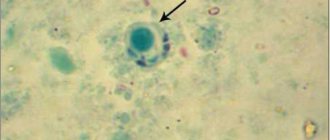Causes of salmonellosis
The causative agent of the infection is the bacterial bacillus Salmonella. This is a persistent bacterium that is not afraid of cold and can live for weeks in a dry environment and for months in water. To date, more than 2,500 varieties of salmonella are known. They differ in varying degrees of aggressiveness, which determines the course of the disease and possible complications.
There are a number of factors that contribute to the spread of infection. First of all, this is the high crowding of children and non-compliance with personal hygiene rules. The risk of infection in infants increases if the rules for introducing complementary foods are violated, as well as if the baby was transferred to artificial feeding early. Children with primary and secondary immunodeficiency are also susceptible to infection.
Symptoms of the disease in children and adults
As soon as you discover signs of poisoning, especially if symptoms of salmonellosis appear in children, you should immediately consult a doctor to avoid complications. You need to know that it is most difficult to treat this disease in children, in contrast to cases when an adult falls ill.
You should wash your hands every time before eating and after using the toilet. Compliance with hygiene rules especially applies to children. It is necessary to regularly carry out antibacterial treatment of cutlery and surfaces, toilets and bathrooms. You need to purchase food products from reliable places. There is also no need to leave food at room temperature. Store and prepare food correctly using simple technology.
A little history
A. Bollinger was the first to trace the connection between diseases of domestic animals and food poisoning of people who consumed their meat in 1876.
- The discovery of pathogens of “meat poisoning” began in 1885, when veterinarians D. Salmon and Th. Smith isolated from the internal organs of pigs Bacteria
- In 1888, A. Gartner isolated similar microorganisms from cow meat and the spleen of the person who consumed it. The bacteria were named Bacteria enteritidis Gartneri? later named Salmonella
- In 1892, F. Loffler isolated Bacteria typhimurium (S, typhimurium) from sick mice.
- The name of the genus “Salmonella” was approved by the International Association of Microbiologists in 1934 in honor of the discoverer of bacteria D. Salmon, and the term “Salmonellosis” began to refer to diseases caused by this group of bacteria.
- In 1954, the international Kauffman-White classification was adopted. It includes more than 1,500 different serological types of Salmonella bacteria.
Rice. 2. American veterinarian, in whose honor the genus of enterobacteria Salmonella is named, Daniel Elmer Salmon.
Diagnostics
Photo: wikipedia.org
Unfortunately, the diagnosis of salmonellosis is difficult due to the similarity of symptoms in the early stages (abdominal pain, loose frequent stools, nausea, vomiting, fever) with other intestinal infections, for example: dysentery, rotavirus infection, shigellosis, cholera.
If abdominal pain is the leading symptom, acute surgical pathology should be excluded. These include: pancreatitis, appendicitis, cholecystitis, gastric and duodenal ulcers, acute intestinal obstruction, thrombosis of mesenteric arteries, acute gynecological diseases. Chronic inflammatory bowel diseases with periods of exacerbations (ulcerative colitis, Crohn's disease, diverticulitis) can also give a similar clinical picture.
One of the main factors in diagnosing salmonellosis is clarifying the medical history, namely contact with animals or eating certain foods. Their analysis for the presence of salmonella allows you to quickly make a diagnosis and begin treatment.
To clarify the pathogen in case of prolonged diarrhea, accompanied by nausea, vomiting, febrile syndrome, a stool sample is taken for bacterioscopic and bacteriological examination. At the same time, flora must be cultured to determine sensitivity to antibiotics.
To clarify the diagnosis, serological methods are used to determine the activity of the body’s immune system against a specific bacterium.
The general blood test will be changed according to the type of bacterial infection: a shift in the leukocyte formula to the left, an increase in the total number of leukocytes, an increase in the erythrocyte sedimentation rate. A blood sample must be taken to determine the bacteria in it, so as not to miss the onset of a generalized infection.
Urine tests in the early stages will not be indicative, but in the case of a generalized infection, if bacteria enter the kidneys and bladder, an increase in the number of white blood cells and the presence of bacteria may be detected in it.
Instrumental research methods only help to exclude other diseases that can cause similar symptoms, but do not confirm salmonellosis.
Symptoms
Photo: dobro-est.com
Salmonellosis is divided into two variants of the course of the disease: generalized and gastrointestinal. The generalized type is also divided into two: septic and typhoid.
The most common and mildest is the gastrointestinal form. It is characterized by a rise in temperature, diarrhea, nausea, abdominal pain, and possible vomiting. The symptoms accompanying this type of salmonellosis do not extend beyond the gastrointestinal tract. The incubation period is short - from 3 hours to 3 days after infection, after which the patient begins to show the symptoms described above.
Characterized by acute pain in the abdomen, most often in the upper part, in the navel area. Symptoms of salmonellosis also include a very high temperature, which can rise up to 40ºC. Stools are frequent - up to 10 times per day and can lead to dehydration. The stool is usually watery and foamy, contains green mucous clumps, and has an unpleasant odor. Bloody discharge may appear a little later, on the third day. This form of the disease usually lasts no more than a week.
The onset of typhoid salmonellosis is similar to the gastrointestinal form of the disease: the patient is bothered by nausea, vomiting, diarrhea, and an increase in body temperature to 39-40 ºC. However, after this, a rash appears on the patient’s skin, and the liver and spleen increase in size. The duration of the typhoid form of the disease is 3-4 weeks, in some cases more than a month. It is more severe and more difficult to treat.
The septic form of salmonellosis is characterized by a massive release of bacteria into the bloodstream and their sedimentation in the small vessels of internal organs. The patient develops sepsis, which is accompanied by renal and heart failure, damage to the heart valves, meninges, and pulmonary edema. The septic form of salmonellosis is a life-threatening condition that requires immediate medical intervention.
Medicines
Photo: vk.com
To restore the water-salt balance, infusions of an isotonic solution of sodium chloride, glucose, and Ringer's solution are used. The volume of infusions may vary depending on the patient's weight and condition. It should be remembered that a rise in body temperature by one degree increases fluid consumption by one liter per day.
For sorption therapy, activated carbon, preparations based on aluminosilicates, and preparations of plant origin that contain pectin and dietary fiber are used.
To compensate for digestive disorders, enzymes (Pancreatin, Creon, Mezim), proton pump blockers (Omeprazole, Pantoprazole) and probiotics (Linex, Enterozermina) are used.
Treatment
Photo: lisa.ru
Treatment of salmonellosis requires inpatient conditions. Even for mild cases of the disease, constant medical supervision is necessary, since the infection can worsen against the background of temporary well-being and relief of symptoms.
Since salmonellosis is almost always accompanied by severe fever, the first step is to restore water and electrolyte balance using infusion therapy.
At the onset of the disease, the use of sorbents is justified, which “absorb” bacteria, removing them from the intestines. If no more than a couple of hours have passed since eating contaminated foods, gastric lavage is indicated.
Digestive dysfunction due to salmonellosis is compensated by taking digestive gland enzymes, probiotic preparations, following a gentle diet (boiled vegetables and dietary meat, low-fat broths, cereals) and restoring fluid losses.
For salmonellosis, antidiarrheal drugs are not used because they delay the removal of bacteria and their toxins from the intestines, which can lead to a worsening of the condition.
The prescription of antibacterial drugs is mandatory. Due to the high antibiotic resistance of salmonella, a combination of 2-3 drugs is often used. Preference is given to drugs with bacteriostatic properties. Such medications slow down or completely stop the growth of bacteria, thus preventing the development of infection. This allows you to avoid increasing the symptoms of intoxication, since the bacteria do not release toxins that are formed when they die.









